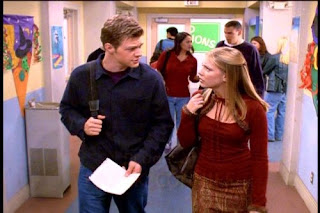1. Viago (Taika Waititi, who also wrote and directed), a Byronesque partyboy.
2. Vladislav (Jemaine Clement), a sexually voracious Dracula.
3. Deacon (Jonathan Brugh, left), a newby (only 183 years old).
4. Petyr (Ben Fransham), an 8,000 year old inarticulate Nosferatu.
They are old-school vampires who vaporize in sunlight, have no reflection, and dislike crucifixes, but they have modern problems, like problems over chores, squabbles with friends and slaves, and how to meet potential victims in the increasingly tech-driven world of modern New Zealand.
Vladislav (left) butts heads with a shrewish female ex-lover, and another re-unites with his long-lost girlfriend. There are no identifiably gay characters. I counted at least one homophobic slur. Yet there is a strong gay subtext in the struggles of four men living together.
Particularly with the newly-vampirized Nick (Cori Gonzalez-Macuer), who displays no heterosexual interest, before or after, and who "comes out" as a vampire to his best friend Stu (Stu Rutherford) in scene full of gay symbolism.
Vampires think of humans as either slaves or prey, so human-vampire friendships are scandalous. Yet when Stu starts hanging out with the vampires, they all come to love him. Then Stu comes as Nick's date to a vampire-zombie-witch masquerade ball, and they risk their lives to save him from becoming an appetizer.
None of the cast is apparently gay, although in interviews they often compare vampires to gay people, who also must "walk in shadows," hidden from a persecuting world.
In 2014? Really?
Still, a perfect little vehicle for getting your mind off the roar of Christmas.
None of the cast is apparently gay, although in interviews they often compare vampires to gay people, who also must "walk in shadows," hidden from a persecuting world.
In 2014? Really?
Still, a perfect little vehicle for getting your mind off the roar of Christmas.














































.jpg)





